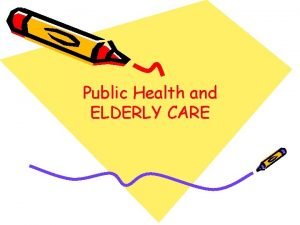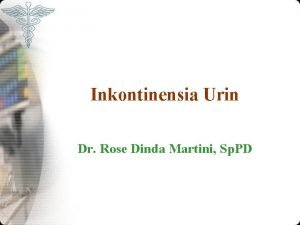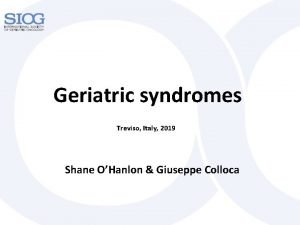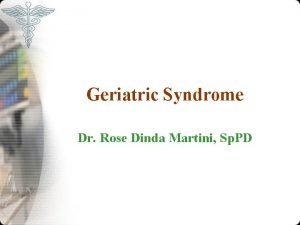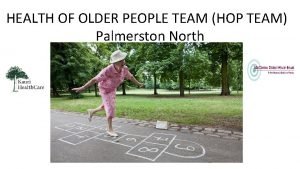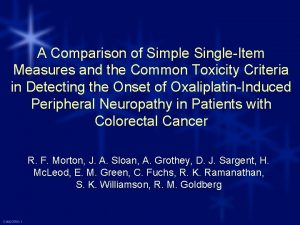Singleitem measures happiness LS health Multiitem scales Geriatric

















- Slides: 17




Способы измерения качества жизни / субъективного благополучия Single-item measures (happiness, LS, health) Multi-item scales: • Geriatric (Philadelphia Geriatric Center Morale Scale) General scales (Index of General Affect, Affect Balance Scale, General Well-being Schedule, Center for Epidemiological Studies Depression Scale (CES-D), CASP-19)












Источники v Bauer et al. (2016) Subjective well-being across the lifespan in Europe and Central Asia. Population Ageing (In Press). v v v Blanchflower, D. G. , & Oswald, A. J. (2004). Well-being over time in Britain and the USA. Journal of Public Economics, 88, 1359– 1386. Bukenya, J. O. , Gebremedhin, T. G. , & Schaeffer, P. V. (2003). Analysis of rural quality of life and health: A spatial approach. Economic Development Quarterly, 17, 280 – 293. Chida, Y. , & Steptoe, A. (2008). Positive psychological well-being and mortality: A quantitative review of prospective observational studies. Psychosomatic Medicine, 70, 741– 756. v Clark, A. (2007). Born to be mild? Cohort effects don’t (fully) explain why well-being is U shaped in age. IZA Discussion Paper No. 3170, pp. 1– 29. v Crimmins, E. M. , & Beltrán-Sánchez, H. (2011). Mortality and morbidity trends: Is there compression of morbidity? The Journals of Gerontology: Series B: Psychological Sciences and Social Sciences, 66 B, 75– 86. v Deaton, A. (2008). Income, health, and well-being around the world: evidence from the Gallup World Poll. Journal of Economic Perspectives, Vol. 22, Issue 2, pp. 53 - 72. v Diener, E. (2002) Subjective Well-being. In E. Diener (Ed. ), The Science of Well-being. Social Indicators Research Series, pp. 11 – 58. v Easterlin, R. (2006). Life cycle happiness and its sources: intersections of psychology, economics, and demography. Journal of Economic Psychology, 27(4), 463– 482. v Easterlin, R. A. (2001). Income and happiness: Towards a unified theory. The Economic Journal, 111(473), pp. 465– 484. v Easterlin, R. , Sawangfa, O. (2007). Happiness and domain satisfaction: theory and evidence. IZA Discussion Paper No. 2584, pp. 1– 35. v Fisher, J. (2009) Happiness and age cycles – return to start…? On the functional relationship between subjective well-being and age. OECD Social, Employment and Migration Working Papers No. 99, pp. 1 – 42. v Gerstorf, D. , Lövdén, M. , Röcke, C. , Smith, J. , & Lindenberger, U. (2007). Well-being affects changes in perceptual speed in advanced old age: longitudinal evidence for a dynamic link. Developmental psychology, 43(3), 705. v Helliwell, J. F. (2002). How’s life? Combining individual and national variables to explain subjective well-being. Economic Modelling, 20, 331 -360. v House, J. S. (1998). Age, work, and well-being: Toward a broader view. In K. W. Schaie and C. Schooler (Eds. ), Impact of work on older adults. New York: Springer. v Hülür, G. , Ram, N. , & Gerstorf, D. (2015). Historical improvements in well-being do not hold in late life: Birth-and death-year cohorts in the United States and Germany. Developmental psychology, 51(7), 998. v Inglehart, R. , Foa, R. , Ponarin, E. and Welzel, C. (2013) Understanding the Russian Malaise: The Collapse and Recovery of Subjective Well-being in Post-communist Russia. Moscow National Research University Higher School of Economics Working Papers BRP 32/SOC/2013.

Источники v Kahn, R. , Juster, T. (2002) Well-being: concepts and measures. Journal of Social Issues, Vol. 58, No. 4, pp. 627 - 644 v Kawachi, I. & Berkman, L. (2001). Social ties and mental health. Journal of Urban Health, 78, 458 -467. v Layte, R. (2012). The association between income inequality and mental health: Testing status anxiety, social capital, and neo -materialist explanations. European Sociological Review, 28(4), 498– 511. v Lopez Ulloa, B. , Moller, V. , Sousa-Poza, A. (2013) How does subjective well-being evolve with age? A literature review. Population Ageing, Vol. 6, pp. 227 – 246. v v Menec, V. H. (2003). The relation between everyday activities and successful aging: A 6 -year longitudinal study. Journals of Gerontology meta-analysis. Psychology and Aging, 15, 187– 224. v Netuveli G. et al. Quality of life at older ages: evidence from the English longitudinal study of aging (wave 1) //Journal of Epidemiology & Community Health. – 2006. – Т. 60. – №. 4. – С. 357 -363. v Penninx. , BWJH, van Tilburg TG, Kriegsman DMW, Boeke, AJP, Deeg DJH & van Eijk JTM. (1999). Social networks, social support, and loneliness in older persons with different chronic diseases. Journal of Aging Health, 11, 151 -168. v Pinquart, M. , & Sörensen, S. (2000). Influences of socioeconomic status, social network, and competence on subjective well-being in later life: A v Realo, A. & Dobewall, H. “Does life satisfaction change with age? A comparison of Estonia, Finland, Latvia, and Sweden. ” Journal of Research in Personality, 45, 297 - 308. , 2011. v Scheider, S. (2016) Income inequality and subjective well-being: trends, challenges, and research directions. Journal of happiness studies, Vol. 17, pp. 1719 – 1739. v Siddiqi, A. , Given, C. , Given, B. , Sikorskii, A. (2009). Quality of life among patients with primary, metastatic and recurrent cancer. European v Skoglund, E. (2017) The Happiness gap between transition and non-transition countries. IZA World of Labor Discussion Paper No. 357, pp. 1 – 11. v Stevenson B. , Wolfers J. (2008) Economic Growth and Subjective Well-Being: Reassessing the Easterlin Paradox. NBER Working Paper Series, pp. 1 – 30. v Veenhoven, R. (1996) Happy life expectancy: “A comparative measure of quality of life in nations. ” Social Indicators Research, 39, pp. 1– 58. v Veenhoven, R. (2009) Well-being in nations and well-being of nations. Is there a conflict between individual and society? Social Indicators Research, Vol. 91, Issue 1, pp. 5 – 21. v Wiggins R. D. et al. Quality of life in the third age: key predictors of the CASP-19 measure //Ageing & Society. – 2004. – Т. 24. – №. 5. – С. 693 -708. v Yang, Yang. Social Inequalities in Happiness in the U. S. 1972 -2004: An Age-Period-Cohort Analysis American Sociological Review 73: 204 -226. , 2008
 Repeated-measures design
Repeated-measures design Symbols for happiness
Symbols for happiness Nothing is more precious than health
Nothing is more precious than health Geriatric giants
Geriatric giants Geriatric giants
Geriatric giants Geriatric syndrome
Geriatric syndrome Objectives of geriatric nursing
Objectives of geriatric nursing Va geriatric scholars program
Va geriatric scholars program Geriatric psychiatry definition
Geriatric psychiatry definition Dr rose dinda martini
Dr rose dinda martini Geriatric giants mnemonic
Geriatric giants mnemonic What is geriatric syndromes
What is geriatric syndromes Geriatric syndrome 14i
Geriatric syndrome 14i Geriatric syndrome
Geriatric syndrome Gems diamond geriatric assessment
Gems diamond geriatric assessment Chapter 10 geriatric care
Chapter 10 geriatric care Gems diamond ems
Gems diamond ems Supportlinks palmerston north
Supportlinks palmerston north






